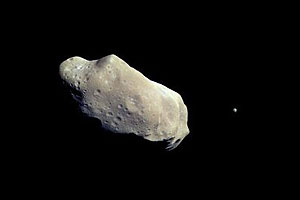 A few weeks ago, this asteroid came really close to hitting Earth.On March 3rd, 2009 at 1:40PM GMT, just a mere month after we'd finished the Asteroid Hunters segment, an asteroid of up to 165 feet in diameter snuck up on us, coming within approximately 37,000 miles from a direct impact with Earth. That's almost seven times closer than the distance to the Moon and about twice the distance of some communications satellites that orbit the earth.
A few weeks ago, this asteroid came really close to hitting Earth.On March 3rd, 2009 at 1:40PM GMT, just a mere month after we'd finished the Asteroid Hunters segment, an asteroid of up to 165 feet in diameter snuck up on us, coming within approximately 37,000 miles from a direct impact with Earth. That's almost seven times closer than the distance to the Moon and about twice the distance of some communications satellites that orbit the earth.
Called “2009 DD45”, the asteroid was estimated to be around the same size as the one that exploded in the atmosphere near the Podkamennaya Tunguska River in remote Siberia on June 30th, 1908, flattening 80 million trees across eight hundred square miles of remote forest. Of course, if an asteroid of this size were to hit a city or in an ocean offshore from a populated area, tens of thousands of people would likely die.
Then, just as the last of the night sky observers were completing their collective sighs of relief, on March 17th, 2009 another Tunguska-class asteroid, 2009 FH, passed by about 53,000 miles from Earth. Thankfully, neither of these asteroids actually hit us. But astronomers didn’t even observe 2009 DD45 until 4 days before its closest approach. It's orbit was calculated and it was determined that it would miss the Earth. But it's likely that asteroids of this size are fairly frequently buzzing by the Earth. And until recently, most of them have been undetected.
In 1998, NASA started the Spaceguard Survey which set out to discover 90% of those Near Earth Asteroids (NEAs) 1 km in diameter and larger. An impact by an asteroid this size would likely cause global destruction and an end to much of life as we know it so it’s definitely reassuring that 10 years after its inception, the Spaceguard Survey had found about 80% (CK) of them. But unfortunately, once we’ve found them, there’s still no international concensus or infrastructure in place in how to deflect or destroy them. But the Survey is limited by its mandate to find those mass extinction-sized asteroids as well as by the size and sophistication of the telescopes that are dedicated to searching the skies.
As former Apollo 9 astronaut, Rusty Schweickart said in a recent phone conversation, "in the process of finding the big ones, you also find a bunch of small ones, and the smaller ones are obviously far more numerous than the large ones." But it will take many more resources and new telescopes to continue searching for and tracking the smaller ones. And unfortunately, once we’ve found them, there's still no international consensus or infrastructure in place in how to deflect or destroy them. Raising awareness and building alliances amongst governments and space agencies is Schweikart's current "mission". He founded the B612 Foundation and Association of Space Explorers to tackle these goals on different fronts.
